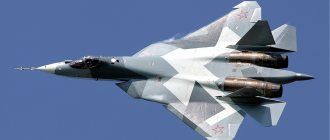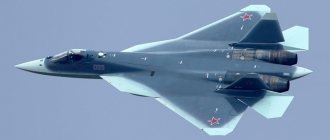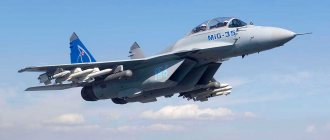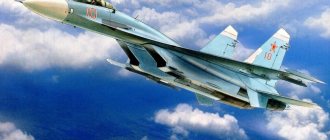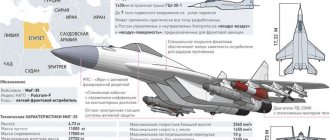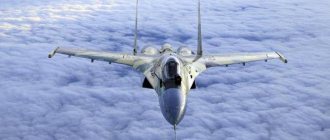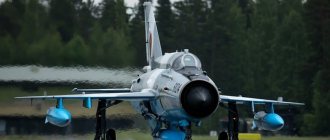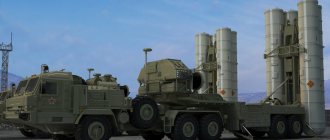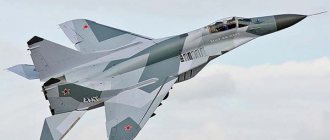The decision of Russian President Vladimir Putin to adjust the state armament program with the aim of purchasing 76 fifth-generation Su-57 fighters became one of the main military news of the year: just recently it was reported that the military department intended to limit itself to purchasing only 15 production aircraft until 2027. Izvestia assessed the prospects of the newest Russian fighter and the possible cost of the program.
Effective stealth: what the Su-57 is capable of
Why the Russian fifth-generation fighter is better prepared for future conflicts than its American competitors
History of creation
The PAK FA T-50, or the advanced front-line aviation complex, is a prototype of the domestic fighter of the latest fifth generation Su-57, developed by the Sukhoi Design Bureau. For 2022, several test samples of the machine with the first stage engine are known. However, a more advanced engine has already been developed, which will be installed on production aircraft in 5–7 years.
Work on creating a fifth-generation fighter began in 2001, when Rosaviakosmos and the Ministry of Defense developed a joint program to develop the latest aircraft. Development work was entrusted to the State Unitary Enterprise "APVK Sukhoi". It was planned that serial production and large-scale delivery of the aircraft to Russian troops would begin in full by 2015, however, for unknown reasons, there were significant delays in the development of the aircraft, which is why, among other things, India withdrew from the program for financing and purchasing aircraft of this project.
Projections of PAK FA T-50-1. Drawing.
Many foreign experts regarded this step as a potential failure of the program to develop the latest generation fighter. However, the fate of the Su-57 today promises to be very promising. According to V.V. Putin, who very highly assessed the prospects of the new fighter, domestically produced serial aircraft will cost the army at least half as much as foreign ones, and therefore a decision was made to continue development.
Considering the novelty of the development, the name of the chief designer, as well as many of the technical characteristics of the machine, are unknown today.
The first tests of the Su-57 aircraft (then T-50) took place at the beginning of 2010. The flight lasting 45 minutes was carried out by Honored Test Pilot Sergei Bogdan. The following year, the test vehicle broke the sound barrier after 40 test flights at subsonic speeds.
In February 2022, 4 Su-57 aircraft were delivered to Syria to test the aircraft’s capabilities in combat conditions. In the skies over the province of Latakia, it was planned to study the weapon system, on-board equipment, as well as the degree of detection by enemy aircraft.
Combat capabilities
The need to purchase a new aircraft is obvious: the upcoming deliveries of fifth-generation F-35 fighters to US allies in Europe in the next decade could seriously change the balance of power not in favor of Russia. Deputy Director of the Center for Analysis of Strategies and Technologies Konstantin Makienko commented on this aspect for Izvestia. “By supplying a small number of modern vehicles, it is possible to create a local advantage in the air, which cannot be allowed, given the very real prospects for the appearance of the F-35 in Eastern European countries,” he noted. — In the early 1980s, with the supply of a relatively small number of F-16s, the United States helped Pakistan achieve local air superiority over the southern regions of Afghanistan adjacent to the Afghanistan-Pakistan border, greatly complicating the actions of the USSR Air Force in these areas. We have no right to allow a similar situation to repeat in areas bordering Russia - for example, over the Baltic states, Ukraine, Belarus, and this is perhaps the most important argument in favor of purchasing the Su-57.”
f35
American fifth-generation multirole fighter-bomber F-35
Photo: REUTERS/Pascal Rossignol
If the Su-57 had been delivered to the troops at the originally planned pace, then the severity of the problem would have been much less: within the framework of the 2011–2020 State Armed Forces, it was previously planned to supply 52 vehicles of this type to the Russian Air Force by the end of 2022. By this point (May 2022), the military would most likely have received about 40 aircraft, and the aircraft would have been put into mass production, which would now make it possible to plan a new, larger contract and increase the rate of mass production - for example, to 15–20 cars per year in the next decade.
Pre-flight expectations: when the Su-57 will go on combat duty
The supply of fifth-generation fighters cannot be delayed
This did not happen: from March 2015, as Izvestia already wrote about, the volume of Su-57 purchases began to decline, and the expected period began to move to the right, which ultimately led to plans for the purchase of two serial fighters in 2022 and 2022 and 13 - in 2021–2027. It hardly makes sense to speculate about the motives that prompted the Russian President to change these plans, announcing his intention to purchase 76 aircraft by 2027 to equip three air regiments, but in principle, the prospects already mentioned above for the appearance of fifth-generation American aircraft in Europe are quite sufficient grounds for such solutions.
76 Su-57 fighters by themselves will not be able to change the balance of power between Russia and NATO as a whole, but this is not required of them. If we consider the role of these aircraft in the Air Force, then in fact these are “high-quality reinforcement” machines capable of dramatically increasing the combat capabilities of an existing aviation group. Taking into account the defensive nature of the Russian military doctrine, such a grouping, including, in addition to the Su-57, modernized fourth-generation vehicles and relying on appropriate support forces - from ground infrastructure to flying tankers and AWACS aircraft, as well as air defense and missile defense systems, can successfully counteract even against a superior enemy.
Su_57
Su-57 fighters accompanying Air Force One during landing, over the airfield of the 929th State Flight Test Center named after V.P. Chkalov of the Russian Aerospace Forces
Photo: RIA Novosti/Alexey Nikolsky
Generation of Crimea: the latest Su-57 fighters will be sent to the southern borders
The aircraft will enter service with regiments in a tense strategic direction
The option of a “cheap” victory with small forces in a hypothetical conflict is excluded in this case, and any potential adversary will have to think about the cost of a possible escalation of the conflict and its consequences - including the possible use of nuclear weapons.
Obviously, this batch will not be the last: the total requirement of the Russian Air Force for the Su-57 is estimated in the range of 200–250 vehicles, and, most likely, deliveries of this volume will stretch until approximately the mid-2030s, even taking into account the expected increase in production rates as development progresses. machines and process improvements.
Characteristics of the Su-57
The characteristics of the Su-57 can be judged very conditionally, since there is no data on models with updated second-stage engines. It is known that the aircraft has a length of 19.4 m and a wingspan of 14 m. In addition, the sweep angle has been increased compared to its predecessors: 48°.
The empty weight of the aircraft is estimated at 18.5 tons, the maximum take-off weight is 35.5 tons. With 63% fuel (normal load), the aircraft is capable of flying 2,700 km at cruising speed and 1,200 km at supersonic without afterburning. The maximum speed of the Su-57 at altitude reaches Mach 2.45, the maximum without afterburner is Mach 2. The height ceiling is 20 km.
The United States is launching production of new fighters because it fears competition with the Russian Su-57. TASS military observer Viktor Litovkin PolitRussia about this .
But the US Air Force will receive a 5 minus generation fighter called the F-36 Kingsnake. This was reported by the American portal Popular Mechanics. As noted, the new aircraft received an F119 turbojet engine with an afterburner and controlled thrust vectoring, which is equipped with the current fifth-generation fighter F-22 Raptor, and an AN/APG-83 Scalable Agile Beam Radar (SABR) radar with an active phased array antenna ( AFAR), which is used on the F-16 Fighting Falcon.
The authors of the material note that the aircraft meets the basic requirements that the US Air Force imposes on a fighter designed to replace the F-16 Fighting Falcon. According to Popular Mechanics, the F-36 Kingsnake has all the features of a fifth-generation fighter except stealth. In particular, the concept involves the use of air-to-air and air-to-ground missiles placed in the internal compartment and on external slings, as well as aerial bombs. However, as TASS military observer, retired colonel Viktor Litovkin PolitRussia , in reality, the US plans to produce a new fighter are not connected at all with the F-16.
“The United States has long been talking about the need to create a new fighter. Now they have announced a replacement for the F-16. However, I would not take these words so literally. Of course, officially it will become a replacement for the F-16, but in reality it will be called upon in order to brighten up the failure of their “best fighter in the world,” the F-35. This miracle of technology, let me remind you, was released unfinished - it has 900 developments. In connection with this, the production of these aircraft has now, as is known, ceased. Their quality is also noticed by buyers, who today number in more than 20 countries. Moreover, 9 states invested in the development of the fighter. Therefore, we need to somehow get out of this situation,” explains the expert.
According to him, American generals might not have become so nervous if the Russian fifth-generation fighter Su-57 had not appeared on the world stage. As Viktor Litovkin notes, the domestic aircraft has already surpassed in its capabilities such advanced American fighters as the F-22 and F-35.
“The S-57 is better than American competitors in everything from combat capabilities to price-quality ratio. We have the most powerful radar, super-maneuverable engines. Finally, we have no shortcomings. And the Americans understand that with the full launch of our fighters on the market, we will gain a tangible advantage and receive new orders. Of course, the United States will not be left without contracts either - at least within NATO there will remain an increased demand for their products. But as far as other countries are concerned, their positions will no longer be so confident,” explains Litovkin.
That is why, the military expert is sure, the United States is now in a hurry to look for a replacement for its flagships, which could be made the main American fighter for export. Otherwise, the successes of the Russian Su-57 will throw the United States far back.
“This new fighter, the F-36, will technically be a replacement for the F-16. But in fact, it will replace the F-35 on the market. It is on this that the main bet will be placed in the future - the fighter will become the main export option. Yes, this will be a somewhat truncated model compared to other fifth-generation aircraft. But, as they say, at least it’s something. Of course, this will entail new costs. Today, all aircraft of this level are expensive - it will be impossible to find a replacement at a cheaper price, and all design work alone will cost 60, or even more, billions of dollars. Their production and operation require a lot of money, like kerosene, which must be absolutely clean. Ammunition and avionics are also very expensive. The release of an entire series will cost hundreds of billions. But if you want to stay in the race, you need to spend money,” sums up Viktor Litovkin.
Earlier, PolitRussia cited the opinion of analysts from the American publication The National Interest, who announced how Russia is forcing the United States to abandon fourth-generation fighters.
Design
The PAK FA drawing is currently strictly classified. The properties of the new military machine can only be judged from open sources. It is known that the Su-57 belongs to the class of heavy fighters, is multifunctional, has high maneuverability and supersonic cruising speed. Also, the new domestic aircraft is inconspicuous thanks to stealth and electronic warfare technologies.
Cabin
The cabin of the Su-57 is designed for one person, but its space is wider than that of the Su-27 due to the design of the airframe. There is an oxygen generator inside the cabin. The information display system is complemented by displaying information on the pilot's helmet glass.
The cockpit canopy is covered with a radio-absorbing compound. It is reported that now its configuration is not final and will undergo changes during mass production. The digital computer takes into account the pilot’s parameters, including height and weight, optimizing the maneuvers and control of the aircraft for them.
For serial production, the designers promise to develop a new life support system, equipment and oxygen system.
Glider
The PAK FA airframe is made according to a normal aerodynamic design and is of an integral type. The shape of the airframe is largely determined by visibility reduction technologies, which is necessary for a fifth-generation fighter. The weight of the body has been reduced through the use of composites: a quarter of the empty weight of the aircraft and 70% of its surface are composites. In addition, the Su-57 has 4 times fewer parts compared to the Su-27, which reduces the time and complexity of assembling the product.
Do you believe that the Su-57 is the future?1
Not really
Engines
The first samples of the Su-57, its prototype, as well as previous models were equipped with AL-41F1 engines, allowing them to reach supersonic speed without the aid of afterburner. This engine had improved fuel consumption characteristics, a fully digital control system, and increased traction force.
However, in the future it is planned to install a new engine for the Su-57, which is currently called “Product 30”, and in the future will receive the index “AL”. This is a completely new engine, with a new fan, control system and hot end. According to a representative of the developers, this engine has no analogues in the world and is capable of not only improving the flight characteristics of the vehicle, but also reducing its visibility.
Avionics
According to the general director of NIIP, the PAK FA radio-electronic system will be fundamentally different from similar systems in the usual sense. The innovative effect will be achieved thanks to a network of active and passive radio and optical location systems that make up the “smart skin” of the aircraft.
It is planned to install an optical-location system on serial Su-57s, which will effectively detect the enemy both in the front and rear hemispheres relative to the aircraft, protect the vehicle from solar erosion, and also reduce the effective scattering area (RCS), which will reduce the visibility of the aircraft.
A new radar, Belka, is being designed for use on the Su-57, since the previous Irbis model cannot be installed on this aircraft model due to inconsistency with the dimensions. A prototype of this system was first demonstrated in 2009.
Stealth
During the development of the PAK FA, aircraft designers were especially puzzled by technologies for reducing visibility, since this is the main requirement for fifth-generation fighters. This term refers to a set of measures to reduce the likelihood of detecting an aircraft in various wave ranges, including acoustically.
In the Su-57 project, stealth for radio waves is achieved thanks to the shape and coating of the aircraft's airframe, as well as electronic warfare equipment. In particular, the design eliminates the mutual arrangement of surfaces at right angles, which eliminates the effect of a corner reflector.
In addition, some of the weapons are located in the internal compartments of the aircraft to reduce radio signature. For visual camouflage, camouflage coloring of the airframe is used. The first Su-57 had a winter deformation color - this means that the protruding parts of the aircraft were painted in dark spots, and the rest - in a light color, which visually deformed the outline of the aircraft in the visible range.
Thermal and sound signatures have been reduced thanks to the new design of the aircraft's engines. The PAK FA also uses a system of passive sensors that allow it to receive information about enemy positions without giving itself away as signals.
Fighter weapons
The armament of the Su-57 allows the PAK FA fighter to be called a universal fighter, capable of hitting both ground and air targets. The maximum combat load of the Russian fifth-generation fighter is 10 tons. The projectiles are located on 16 suspension points: eight internal and eight external. For air combat, air-to-air missiles can be located in the main weapon compartments:
- up to 6 medium range;
- up to 4 short range.
The following weapons are provided against ground targets:
- up to 4 KAB-500, adjustable bombs;
- up to 4 X-38, high-precision missiles;
- up to 2 X-58, anti-location missiles.
In addition, new types of weapons are being developed for production Su-57s, which will be supplied along with newly produced aircraft for service in the Air Force.
Why the Su-57 turned out to be an expensive and useless toy
Mass production of the newest Su-57 fighter “does not need to be forced.” This was first discussed by the new curator of the defense complex, and then by the head of the relevant State Duma commission. But just a few years ago very serious hopes were placed on this fifth-generation car - which, it seems, the project did not justify at all. What went wrong?
In an era of rapid technological development, the fifth-generation fighter Su-57 will quickly become obsolete, so we need to focus on developing a new, sixth-generation aircraft. This was stated by Vladimir Gutenev, a member of the State Duma expert council on the aviation industry, head of the Duma commission on legal support for the development of defense organizations. “The Su-57 will not be purchased en masse in the interests of the Aerospace Forces. But the car has excellent export potential; many countries would want to purchase it,” Gutenev told Interfax.
Let’s leave it to the deputy’s conscience to state the “excellent export potential” - foreigners always buy only those vehicles that the Russian army itself prefers to use. One statement of the deputy contradicts another - if the Su-57 is not purchased en masse in the interests of the Aerospace Forces, its export potential can be safely put to rest. The most important thing is why does the deputy confirm that the Russian Air Force, in fact, is abandoning the aircraft on which such hopes were pinned and such enormous funds were invested in the development of which?
Such a harsh judgment cannot be considered the opinion of an individual deputy, even from a specialized commission. Gutenev emphasized that he agrees with the opinion of the new curator of the defense industry, Deputy Prime Minister Yuri Borisov, in the recent past deputy minister of defense. There is no point in speeding up mass production of the Su-57, Borisov said on Monday on the Rossiya 24 channel.
The Deputy Prime Minister paid tribute to the qualities of this fighter: the Su-57 “performed very well, including in Syria, and confirmed its flight performance and combat capabilities.” But at the same time, Borisov noted: today, one of the best aircraft in the world is considered to be the representative of the previous generation “4+” - the Su-35. Apparently, the Su-35 is a quite effective and at the same time not so expensive option.
Deputy Gutenev made a similar argument. The Aerospace Forces are already armed with some of the best Su-35S fighters in the world, he said. According to Gutenev, these “4+” generation vehicles are superior in combat qualities not only to their main American counterparts - the F-15 and F-16. To some extent, the Su-35 is not inferior to the F-35 and F-22 - fifth-generation aircraft, the deputy believes.
Such conclusions contrast with the promising plans announced at the beginning of work on the T-50 (this was the factory index of the current Su-57). The development of this fifth-generation fighter within the framework of the PAK FA project (advanced aviation complex for front-line aviation) began back in 2001–2002. It was planned that the fifth generation fighter, at the forefront of military-technical thought (stealth technologies, advanced avionics, powerful radars), should become a counterweight to the F-22 and F-35.
Investments in the project were more than impressive. Nine years after the start of work, in 2010, President Vladimir Putin stated that about 30 billion rubles were spent on the first stage of creating the aircraft alone. The same amount, according to the head of state, was required to complete the work.
Then, in 2010, the first flight was made. The Ministry of Defense planned that mass production of new aircraft would begin at the end of 2016. From 2016 to this year alone, the Air Force was supposed to receive eight T-50s annually. The state armament program until 2020 included the purchase of 52 vehicles. It was planned to form two regiments. But, as they say, “something went wrong.” After 17 years from the start of work, Deputy Prime Minister Borisov stated: the tests of the Su-57 are “proceeding according to plan” (that is, it is still far from entering series production), and in 2022 only two prototypes should be accepted into the Aerospace Forces. Experienced, not serial at all.
Deviations from the set course could be noticed back in 2015. The same Yuri Borisov, then with the rank of deputy head of the Ministry of Defense, reported: Sergei Shoigu’s department reserves the right to revise the number of purchased vehicles. Only 12 T-50 aircraft were “contracted”. On the other hand, last year the Ministry of Defense ordered nearly a hundred Su-35S and more than 100 Su-30SM.
Experts believe that the reason for the decline in interest in the Su-57 was “interspecies” competition.
Firstly, in terms of its characteristics, the Su-35 is almost as good as the Su-57. Secondly, the existing models of the newest Su-57 have outdated engines - similar to those used on the Su-brand vehicles operating in the Air Force. The modernization of this “engine” took 14 years, and only in April were state bench tests completed. In May it was reported: the “T-50-2 flying laboratory” (Su-57 prototype) continues flight tests with a second-stage engine. But this engine, called “product 30,” as expected, should have been in use for a long time.
This is due to the specificity that emerged back in Soviet times - the newest aircraft appear before the engines they need are developed and tested (and this is understandable, given the complexity of manufacturing this most important element of the aircraft).
Thirdly, there is the issue of cost. The price of one Su-57 unit is about 50 million dollars, or 3.16 billion rubles. For comparison, in 2014, the then Air Force Commander-in-Chief Viktor Bondarev complained about the high cost of the Su-30, Su-35 and Su-34 entering the army: “Each aircraft costs more than 1 billion rubles!” Let us recall that in the early 1970s, excessive costs “buried” the project of the promising Su-100 missile-carrying bomber. And not him alone.
The current interest shown by the military department in the Su-35 is completely justified. “The fighter has established itself as an excellent aircraft with good flight range performance. It is important that it can be used as a multi-role aircraft, as a front-line bomber, even as an escort aircraft with a good range - with the “engines” that are on it. And I think that this is not the last engine, they will continue to be developed in terms of increasing its flight range,” explained former instructor pilot, Air Force Major Andrei Krasnoperov. Such a “4++ class” aircraft lacks one plus to be completely invisible to radars, the expert notes.
As for the Su-57, Krasnoperov believes that it is “let’s say, a more expensive toy.”
“The fact that the characteristics of the Su-57 are very similar to the Su-35, especially in terms of the engine, is understandable, but development of a new engine is underway, and it will appear. “All this does not come immediately and, naturally, requires costs,” the pilot emphasizes. In the meantime, “in order to maintain the defense capability of our country at the required level, it is necessary to purchase those aircraft that are available and that are reliable - this applies primarily to the Su-35,” Krasnoperov emphasizes. Let us add that this raises the question: why was the bet on the Su-35 not made earlier?
The expert also recalls that “American F-series aircraft suffered several crashes and, in general, they have many failures. That is, the project is damp.” Let us recall that the F-35 fighter, the latest and extremely expensive (Lockheed Martin presented the reduction in its cost from 100 million to 85 million dollars apiece as an achievement), was subjected to severe criticism. In particular, much was said about his problems with ejection, which, apparently, have not yet been resolved.
Critics express the opinion that high-tech but expensive fifth-generation fighters, both domestic and American, represent a kind of “dead-end branch” in the evolution of combat aircraft. It cannot be said that the Ministry of Defense directly confirms this opinion. But let us pay attention to the statement of Deputy Gutenev mentioned at the beginning. He, among other things, said that work should begin on a next-generation combat aircraft, which would become a transitional link between manned and unmanned aircraft.
And this means that we will most likely never see mass production of the Su-57.
Mikhail Moshkin
Cost of Su-57
Due to the fact that serial deliveries of the PAK FA to the Air Force have not yet begun, the cost of purchasing these aircraft has not yet been disclosed to the general public. What is clear is that the cost of the Su-57 for the Russian army will be significantly lower than for foreign buyers.
Based on the price of its closest analogues, we can say that the price of a domestic innovative fighter will be approximately 120–150 million dollars per unit. Thus, the closest in concept is the fifth generation American F-22, which is supplied at a price of $150 million per aircraft.
Russian Aviation
The cost of the contract for 76 Su-57 fighters to form three air regiments, according to the Kommersant newspaper, is 170 billion rubles, which is approximately $2.6 billion at the rate of 65 rubles per $1, or about $35.6 million for one aircraft. Various analysts and experts both in Russia and the West were extremely surprised at such an uncharacteristically low cost of the fighter.
Indeed, a contract for the export of 24 Su-35S aircraft for the Chinese Air Force in 2015 was valued at approximately $83.3 million per aircraft. In 2022, it was clarified that one Su-35S will cost China more than $104 million, which is 289% of the price of the Su-57. Despite the fact that the Su-35S is a 4++ generation machine, the fighter is older and significantly inferior in its combat capabilities to the Su-57.
The estimated cost of the fifth-generation fighter has led to a number of claims that the listed price is not accurate. Western sources placed special emphasis on the relatively small scale of mass production of the Su-57 compared to the Su-35S and American fifth-generation aircraft F-35A. However, there are a number of factors that can explain the much lower cost of the Russian Su-57 than experts assume.
The first explanation is that the cost only includes the production of the aircraft - without taking into account the costs of research and development, which are already included in the program and will not increase regardless of the number of fighters ordered. This can have a very strong impact on the price of a combat aircraft. The American equivalent of the Su-57, the F-22, whose production ended in 2009, is a prime example of this.
A 2009 report from the US Center for Strategic and Budgetary Analysis (CSBA) documented that after including research and development (R&D) costs of more than $24 billion, costs per fighter aircraft increased substantially, from $150 million to $350 million. As a result, costs increased by 250%, and the cost of one car increased from $35 million in 1985 prices to approximately $60 million in 2009.
The second factor explaining the economic efficiency of the Russian defense sector when its value is measured in US dollars is the lack of purchasing power parity between the ruble and the US dollar. With a cheap ruble, a dollar can buy much more in Russia than in Europe or the USA. While this does not explain the lower cost of the Su-57 compared to the Su-35S, it does explain why the Russian fighter is much cheaper than the American one.
The cost of living in Russia is significantly lower than in the United States or the European Union, and tens, if not hundreds of thousands of specialists participating in the program are paid much less than their colleagues in the West. This is the key to Russia's lower-cost defense sector, which undercuts competition with the West in terms of pricing.
The third factor explaining the low price of the Su-57 is the agreement with the United Aircraft Corporation to reduce profits and better satisfy domestic demand. This resulted in a cost reduction of about 20%, meaning the fighter's original price was just over $42 million, or a little more than 2/3 the cost of the F-22. This also goes a long way in explaining the higher cost of Su-35S aircraft purchased by China, with aircraft manufactured for export costing more to generate greater profits for reinvestment in its own aircraft industry.
It should also be noted that the contract for the Su-35S provided for the supply of ground support equipment, spare engines and ammunition. The costs of transferring modern high technologies, which are estimated at hundreds of millions of dollars of Russian investment in research and development, were also taken into account. Thus, the actual cost of the Su-35S, even with export deliveries, is significantly lower than $83 million.
The cost of the Su-57's weapons is extremely high. Fully armed and with a sufficient arsenal of ammunition, the Su-57 could cost more than $50 million. Considering the costs of pilot training, spare parts and engines, and new maintenance infrastructure, the price will be even higher. Thus, the cost of export versions of the fighter, taking into account UAC profits, may well reach $100 million, especially if the contracts provide for pilot training, which most likely will happen, given the novelty and complexity of the aircraft.
So, let's summarize.
The initial cost of the innovative, first fifth-generation fighter F-22 in 1985 prices was $35 million. By the end of serial production of the aircraft, it had grown to $60 million in 2009 prices.
The initial cost of the first Russian serial fighter of the fifth generation was approximately 42 million dollars. Due to optimization of production and reduction of UAC profits, the price was reduced by 20% and amounted to approximately $35 million.
Who will the “Hunter” hunt?
The cost of the export version of the Su-57E can reach 100 million dollars or more due to the inclusion in the contract of additional conditions for armament, infrastructure, training of flight and maintenance personnel, technology transfer and compensation for the decrease in UAC profits in the domestic market.
The cost of the fighter will increase after it passes tests and the second stage engine “product 30” begins to be installed on the aircraft.
A contract for the supply of 76 Su-57 fighters to the Russian Aerospace Forces may be signed at the MAKS-2019 aerospace salon, which will be held in Zhukovsky near Moscow from August 27 to September 1. We will probably find out the exact cost of the fighter at the end of the summer.
Sources: https://inosmi.ru/military/20180614/242475904.html https://militarywatchmagazine.com/article/russia-s-new-su-57-fighters-cost-just-35-million-each-are -fifth-generation-jets-really-cheaper-than-the-su-35 https://csbaonline.org/research/publications/the-f-22-program-in-retrospect/publication
- 11/02/2020 Su-57 will receive the second stage engine “product 30” in 2022
- 11.11.2018 Formula for success: Su-57=f22+f35
- 11/25/2018 Su-57 - a combat flying supercomputer
- 11/24/2018 Su-57 - safe fuel system and all-seeing radar
( 17 ratings, average: 5.00 out of 5)
Su-57
Export modification
The version of the Su-57 for delivery to other countries (first of all, deliveries to India were planned) was called FGFA. India, together with the United Aircraft Corporation, sponsored the development of the PAK FA and partially took part in it.
However, in 2022, the Indian side withdrew from the project, explaining that the declared characteristics of the future aircraft do not correspond to the actual ones, and also that many of the systems of the projected aircraft do not correspond to the parameters of the fifth generation. At the moment, the potential importing country of the Su-57 is Peru.
